Kyoto: A Buddhist View (Part 4)
Top Photo: MSY000028さん on PhotoAC
It’s been an informative journey, but all good things must come to an end. We conclude with author Nicholas Lemon’s travelogue of popular sites in Kyoto, with an emphasis on their history as related to Buddhism.
Reflections
Kiyomizu-dera temple was my first actual temple visit in Japan. I did have a short shrine visit ten years prior in Tokyo, but May 19th 2016 was the day I first stepped foot on a Buddhist temple in Japan. I bashfully admit this is a point of nostalgia for me. I honestly didn’t know at the time how fortunate I was to stay at a Higashiyama hotel just a short uphill walk from the premise on Kiyomizu-mae (Kiyomizu’s access road).
That day I spoiled myself on some local confectionery, such as yatsuhashi (八ツ橋, which are glutinous rice flour pouches filled with fruit jam or sweet bean paste called anko). And I dined in a hole-in-the-wall sushi restaurant. I knew very little Japanese, but most of the people who greeted me were so polite, even though I’m sure I looked rather unusual to them at the time.
I think, if I had a chance to have another “first visit” in Kyoto, I don’t think I would change a thing about the location, nor the destination. I would have simply changed some of my own actions and been more adamant about studying practical Japanese conversation.
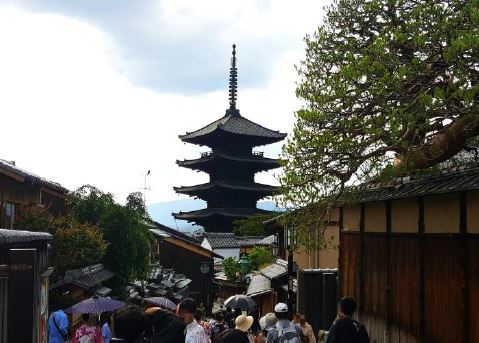
Photo: Ninenzaka, the historic thoroughfare in Higashiyama district leading to Kiyomizu-dera, (August 2019), Nicholas Lemon
For the longest time I avoided Rokuon-ji specifically because of the gold motif of the Kinkaku golden pavilion. But I eventually visited there for work with my tour company, and I learned a lot from that experience. I am still unmoved from my aversion towards gold, and the clearly contradictory issue it proposes as a Buddhist symbol, but I suppose it is understandable that keepers of the shariden, reliquary hall would want to designate it in this way.
The garden itself is a beautiful setting, and the pavilion is like something out of a fantasy novel. And despite the shariden having been a symbol of oppressive feudal power in the past, it now serves almost as a communal museum piece for even common people to view. In that sense, my demeanor towards the site changed completely.
And I suppose the most virtuous thing about Kinkaku-ji is that the site has brought commerce and plenty of joyful memories to so many people. And that, I think, is validation enough, for even the Buddha to be content with. In the spirit of muditā (a Pali word meaning “empathic joy”), I have been able to enjoy the site in the company of other people who found joy in their visit.
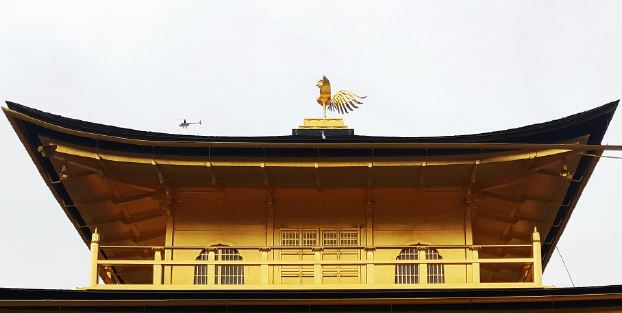
Photo: Detail of Kinkaku’s Hō-ō phoenix ornament at Rokuon-ji Temple with a cameo from a passing helicopter, (May 2018), Nicholas Lemon
At the very top of the Kinkaku is perched a Hō-ō ornament (鳳凰, from Chinese, fenghuang “golden phoenix”). Some sources say the mythical creature has symbolized the Japanese goddess of the Sun, Amaterasu. But here I think the Hō-ō is more connected with the Buddhist tradition extending from China, what with all of the architectural influences and affiliation with the Zen sect.
And in some sense this phoenix has been open to interpretation. For me the ornament is a triumphant declaration that the shariden has been resurrected, from war, poverty, and postwar depression- the site has become a site for people from around the world to come and establish new memories.
I have visited Rokuon-ji several times since living in Japan, and I have been delighted to hear Mandarin, Korean, Swedish, German, French, Portuguese, Spanish, Dutch, and many other languages spoken there. Sadly, the pandemic has halted frequent travel for the time-being.
But I am optimistic that, like the Kinkaku pavilion, the whole world might be restored, and bolstered further still, and will rise from the ashes fully converted from a state of exclusivity into one of plurality and inclusivity.
☸
Thank you for joining us these past few weeks for a different sort of look at Kyoto. We hope you’ll continue to enjoy twice-a-week articles here on MUSUBI throughout the rest of 2023!
Photo Credits:
Top Photo: MSY000028さん on PhotoAC
Additional images provided by the original author (Nicholas Lemon), used with permission
All other content (text) created by the original author and © 2023 MUSUBI by Borderlink
We continue with author Nicholas Lemon’s travelogue of popular sites in Kyoto, with an emphasis on their history as related to Buddhism.
Let’s Talk About Gold
To be totally up front with you, I am not a fan of gold. I don’t like the color. I don’t see any inherent value in it beyond artistry and as a conductor. And I struggle with understanding how gold; a color typically used to illustrate greed in the West is the focal point of a Buddhist temple (examples of this symbolism in Western folklore range from Midas – to the dragon Fafnir in Norse mythology– to Scrooge McDuck). But Kinkaku-ji’s pavilion wasn’t always as gilded as it is today. Shōgun Ashikaga Yoshimitsu was the founding patron of the complex, but it wasn’t donated to the Rinzai Zen sect until his death in 1408 CE as per his will. He purchased the land from descendants of the renowned waka poet, Saionji Kintsune in 1397 CE.
The Ōnin war (centered in Kyoto from 1467 to 1477 CE) laid waste to the entire temple complex, and barely left the pavilion in its place. In the dawn of the Edo period, Abbot Saisho Shotai (1548-1607 CE) was appointed by shogun Tokugawa Ieyasu to head Rokuon-ji, and the temple was sponsored and designated as an official center for Zen practice. However, the Meiji restoration period (1868-1912 CE) was a period of civil war, and bitter feuds erupted between people of all different factions.
As a result, the temple lost all of its financial support and fell upon hard times. The pavilion was in such disrepair that by 1886 the pavilion’s gold leaf was almost completely peeled off. Attempts at restoring gold leaf to the original Kukkyō-chō (究竟頂literally “research spire”, the third floor that was modeled in a Chinese Chan/Zen variation) and at repairing the bottom two floors was further disrupted in 1950, when the Second World War was in the living memories of everyone, a tragic novice monk, Hayashi Yoken, burned it down, presumably because he struggled with mental illness (schizophrenia and a persecution complex). The deed resulted in a speculative public discourse on Yoken’s motivations that could be said to have culminated into Yukio Mishima’s 1956 novel, The Temple of the Golden Pavilion.
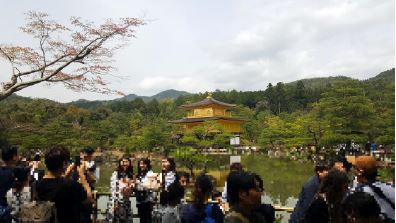
Photo: The popular Kinkaku Golden Pavilion at Rokuon-ji Temple, (May 2018), Nicholas Lemon
The pavilion was swiftly, yet methodically, repaired just a year before the novel’s release, in 1955 and this time it was gilded with gold on the reconstructed Kukkyō-chō as well as the Cho’on-dō (潮音洞literally “tidal sound den”, the second floor designed in the samurai residential style known as buke-zukuri, 武家造literally “samurai construction”). By 1987 the structure was completed in roughly the same way it appears today, but with even thicker gold leaf. The symbolism of the gold structure is more an indication of its roots in the Ashikaga clan, and a continued effort to preserve the legacy of the bakufu (shogunate’s) power center in the Kitayama (北山literally “North Mountain”) district of Kyoto city.
Well, that explains the exterior, and possibly the more popular elements of the pavilion. But there are also the deeper elements of the temple that do designate the structure as Buddhist in culture and tradition.
The interior of the pavilion is off limits to the average tourist, but if you look across the garden pond into the ground floor the Hōssui-in (放水院)— which is built in the shinden-zukuri style (寝殿造the Heian-kyō palatial style of garden architecture) —you would see statues of Gautama Buddha. The structure symbolically serves as a shariden (舎利殿, literally “reliquary hall”) that is said to contain the ashes of the Buddha. The unseen interior of the Cho’on-dō (second floor) contains murals surrounding a statue of the bodhisattva of mercy and compassion- Kannon.
Understanding a Bodhisattva
For me, this is symbolic in two ways. For one, Kannon is an emanation of the Buddha (in my view) that represents a conscientious mind that hears the beckoning of those experiencing the worst of tribulations, yet like a guardian angel, she remains unseen by the common gaze. And secondly, the position of Kannon above Gautama Buddha represents the fact that the former is in a vantage point to receive such cries, and the latter is in his position of Samadhi (perfect concentration and meditative consciousness) as he is grounded to the Earth.
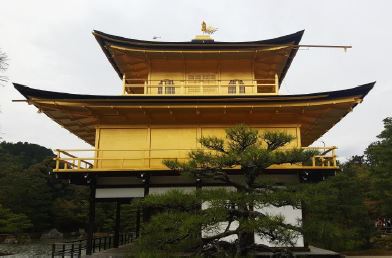
Photo: Kinkaku Golden Pavilion at Rokuon-ji Temple, (May 2018), Nicholas Lemon
The Buddha is often an archetype for one who is grounded in their views and equanimous in the face of tribulations. He is an archetype for the individual coming to grips with adversity and overcoming that adversity with sheer determination and mindfulness.
Kannon is a bodhisattva that represents compassion and the understanding we feel for others with whom we share an empathic connection. Kannon has her history in an early Chinese syncretic blend of folk religion and Buddhism that developed sometime in the Song dynasty (960-1279 CE). Before then, Kannon was imagined as a masculine figure with differing attributes, as opposed to the feminine form that assumes the divine feminine visage. The Chinese alias given to Kannon is Guanyin (觀音contraction of觀世音 “perceiver of the sounds of the world”) and her somewhat anomalous Sanskrit appellation is Avalokiteśvara.
I say anomalous because the –īśvara suffix of her name is more keeping in the tradition of Hindu doctrinal worship of Shiva as a creator god of the universe. This cosmology is not shared beyond Hindu projections onto Buddhism (this happens in areas of majority Hindu populations), and so this appellation is somewhat out of place. For me, these signs of syncretism trouble notions of what is “truth” in the orthopraxy (traditional practice for the sake of proper conduct) of lay people in Buddhism or any other belief system.
However, I respect the archetype of Kannon as being a symbol of compassion personified because she becomes a useful aid for teaching ethical principles to people, like Sakanoue no Tamuramaro, who struggle with empathy and compassion…
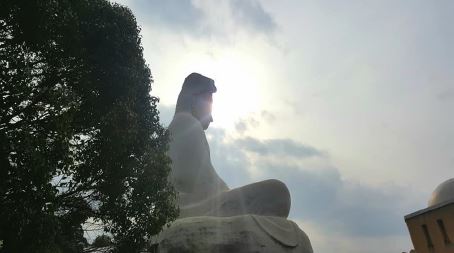
Photo: Kannon Statue, Ryōzen Kannon Pacific War memorial, (February 2020), Nicholas Lemon
The tour concludes with some final reflections next Tuesday on MUSUBI!
Photo Credits:
Additional images provided by the original author (Nicholas Lemon), used with permission
All other content (text) created by the original author and © 2023 MUSUBI by Borderlink
Top Photo: photoBさん on PhotoAC
We continue with author Nicholas Lemon’s travelogue of popular sites in Kyoto, with an emphasis on their history as related to Buddhism.
Identifying a Buddhist Structure
The Niō of the Niō-mon gate are Mahayana Buddhist deities that originate from Hindu devas (demi gods) given the task to guard the temple grounds from evil intentions. Their gaze is fierce, and many Western people mistake them for demons. Devas are deities borrowed from Hinduism and many Buddhists like myself understand them to be allegorical archetypes as opposed to supernatural beings.
The Sanju no tō pagoda symbolically represents the Buddha’s transcendence into parinibbāna (Pali for the ascension into eternal Nirvana upon enlightened person’s death). Yet the function of Japanese pagodas has changed over time and between sects. It is not uncommon to see depictions of Gautama Buddha (the first Buddha, and my principal Buddha), Amidha Buddha (the Pure Land sect’s principal Buddha), or Vairocana (Dainichi) Buddha (the Shingon sect’s principal Buddha) among a procession of devas. Since pagodas are actually successor edifices to stupas (burial mounds encased in stone), they were traditionally used to house the remains and relics of deceased monks. Some pagodas may still serve this function.
But that purpose has mostly been given to the shariden in Japanese sects (this structure will be discussed in more detail below). The Kyo-Dō houses the library of sutras (Buddhist literature) and reading/study rooms. The Kaisan-dō commemorates the abbot and his line of succession within the monastery. Each of these buildings is expressly Buddhist, but they resemble Shinto shrine color schemes. And whenever I inquired about this, I was given the same ambivalent reply as always.
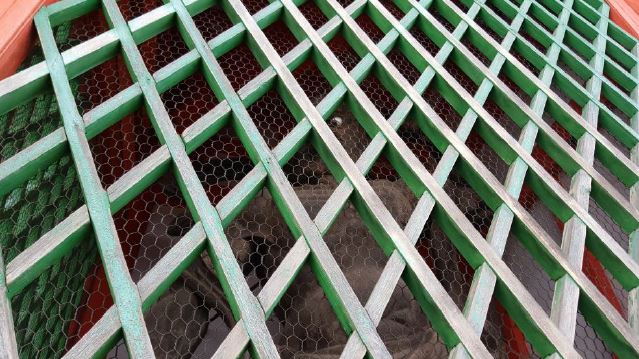
Photo: Kiyomizu-dera, Niō-mon Deva guardian gate, (September 2017), Nicholas Lemon
The Mystery Deepens
Luckily I have taken some knowledge with me from my time living and studying in China before moving to Japan. And there I learned that the Tang dynasty (c. 618- 907 CE, China’s contemporary era to Japan’s Nara period) featured the great Dàcí’ēn Sì (大慈恩寺 literally “the Temple of Grand Benevolence”) in Xi’an. And I visited the reconstruction of that very temple just months before my arrival in Japan in 2016. And Dàcí’ēn Sì was an ancient center for the Fǎxiàng-zōng sect of Chinese Buddhism, which is pronounced Hossō-shu in Japanese- the Hossō sect.
After looking back at my materials from Dàcí’ēn Sì, I learned the sect has the tradition of using red on white as a scheme for their buildings that goes back to the Tang dynasty. And the reconstructed structures reflect that tradition today in modern Xi’an.
Kiyomizu-dera is actually considered a branch temple of Kōfuku-ji temple in Nara and was commissioned by shogun, Sakanoue no Tamuramaro (758-811 CE). There is a long circulated tale that the founding abbot I mentioned earlier was the esoteric monk named Enchin (814–891 CE) (this is dubious for many reasons, notably Enchin’s sectarian affiliation and the fact he was not a contemporary of Sakunoe no Tamuramaro).
The Story of Enchin
As the story goes, Enchin dreamed that Kannon, the bodhisattva of mercy and compassion, urged him to navigate the Kizugawa River from Nara and to find a font flowing with pristine waters. Upon his whimsical journey to Kyoto he discovered Otowa waterfall in the Higashiyama mountain range.
A Buddhist hermit named Gyōei Koji was waiting for Enchin there to lend him a sacred piece of wood so that he may carve a statue of Kannon and enshrine it at his home atop the mountain. Sakanoue no Tamuramaro eventually discovered Gyōei Koji’s abode in Higashiyama while hunting deer and seeking a means to pray for his ailing wife.
The shogun met Enchin at the newfound altar and was given a lecture inspired by the parables of Kannon. He was given the invaluable hōgo (法語 translated “dharma talk” or “sermon”) on the sanctity of all life, and that compassion prevails over all unskillful mental states.
Sakanoue no Tamuramaro was overcome by his own guilt for killing a deer so close to Kannon’s sanctuary that he was a Buddhist convert on the spot. He consequently ordered a larger structure to be built upon the Otowa mount and waterfall, and this was the point from which the rest of Kiyomizu-dera was built and it was administered to be put under the jurisdiction of Kōfuku-ji in Nara.
Next Time: The Golden Pavillion!
This early relationship with Nara as its headquarters stands out in Kyoto as it is a contrast with a majority of Kyoto’s popular temples which are typically headquartered within Kyoto city. One easy example comes to mind: Kinkaku-ji (金閣寺literally “Golden Pavilion Temple”; officially Rokuon-ji鹿苑寺, literally “Deer Garden Temple”), although more famous by leagues than its headquarters, Shokoku-ji temple (相国寺), it is still headquartered in the latter’s location, in a more discreet property at the center of Kyoto city.
Speaking of which, on the topic of painted and gilded edifices: The discussion of Kinkaku-ji’s golden pavilion often centers around the significance of gold in Buddhist settings. To many, it seems this extravagant choice for Buddhist architecture is out of place. And I was initially on the critical end of this debate, but my stance has shifted, if just a little since. So, to explain what I mean, let’s go further north into Kyoto’s Kitayama district to discuss Kinkaku-ji…
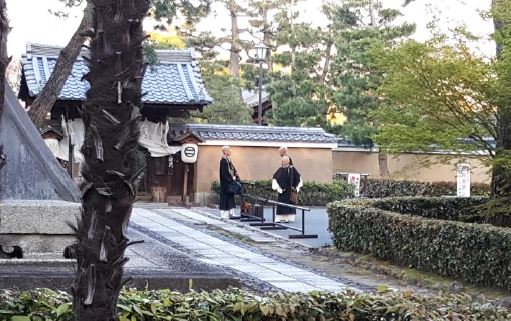
Photo: Zen monks at Shokoku-ji Temple’s Senmon Dōjō, (November 2019), Nicholas Lemon
Join us this Friday for the continuation here on MUSUBI!
Photo Credits:
Top Photo: photoBさん on PhotoAC
Additional images provided by the original author (Nicholas Lemon), used with permission
All other content (text) created by the original author and © 2023 MUSUBI by Borderlink
Top Photo: LeonardoYasuさん on PhotoAC
Over the next week, join author Nicholas Lemon for an insightful and unique look at two of Kyoto’s most popular sites from a western Buddhist’s perspective
Living as a foreign resident in Japan, I’ve always taken note whenever I visit a nearby bookstore’s English section, and the shelves of books on local and national tourism. Given the volumes and variety of cultural sites, I feel like writing about Japan really is just an oversaturated market.
But then it occurred to me that every experience is unique. And some people, no matter how many volumes they read, will always be eager to compare and contrast new and differing insights and perspectives. It helps that I have experience in tour guiding and living as a graduate student in Kyoto, so I think I could offer a fresh way to see the ancient capital and cultural heart of Japan. So, I invite you to come with me on my tour journal around Kyoto, using some of the photos I have taken and my own thoughts on the experiences.
But First: About the Author
Before we go, I should share some things about myself. For starters, I’m from the United States. I hail from Stetson University, DeLand, Florida where I received my BA in political science and international studies. I was also a graduate student at Doshisha University’s Graduate School of Global Studies in American and peace studies.
But that is not the extent to my educational background. I have taken various courses on the humanities, religious studies (including religions of the East), Western, Eastern, and Buddhist philosophy. Although, like many of my fellow Americans, I was nominally Christian in my early years, I’ve progressively taken to declaring myself a Buddhist. I dabbled with being an agnostic theist, and had a long, drawn-out phase defined by firm skepticism. Through the span of about six years, more and more I began to identify with a more ‘secular’ form of Buddhism.
I believe it is helpful for a speaker or guide to show which lens they view the world through in order to give a better understanding of their perspective. At times, I am surprised at myself when I admit I am a Buddhist to others. The title never really seems so important, but my worldview has changed so dramatically through my upbringing, and I think it also seems to contrast with other worldviews.
It’s funny really, because I always find myself discussing Buddhism among Japanese people, whether adults or the children I’ve guided on tours, even if it was unsolicited. My broken Japanese is the usual barrier to understanding. At which point I can tell the majority of people I speak to are in a hurry to find a way to tactfully end the conversation.
When fluent conversation is manageable, we inevitably hover around superficial discussion topics. This becomes really intriguing to me at times, especially when my Japanese interlocutor is unable to express the difference between a Shinto shrine and a Buddhist temple. And this is the mistake so many of us foreign Japanophiles make when coming to Japan.
We tend to think every Japanese person is going to know every bit of trivial knowledge we studied up on before arriving. But that just isn’t the case. And it is also ironic because being outspoken is just not a social virtue in Japan. So my ability to differentiate Shinto and Buddhist traditions is typically informed by reading books and literature available on site at the relevant point of interest. This is what I did in order to write this very article exploring the two most popular sites in Kyoto city: Kiyomizu-dera temple, and Kinkaku-ji temple. Anyways, enough about me- let’s move on to our first destination: Kiyomizu-dera temple.
Kiyomizu-dera: A Site for Syncretism
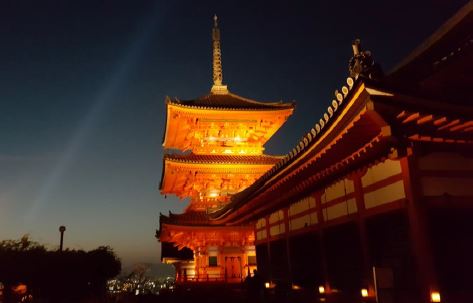
Photo: Kiyomizu-dera, Kyo-Dō sutra hall and Sanju no tō Pagoda, autumn illumination, (November 2016), Nicholas Lemon
Syncretism is the common religious or cultural practice of blending beliefs from different origins. Many who study Japanese culture will quickly come to realize that syncretism is pretty much found everywhere in Japan. So, it stands to reason many people find it hard to distinguish Buddhist temples from Shinto shrines.
Take Kyoto’s Kiyomizu-dera (清水寺, literally “Pure Water Temple”), which is possibly their most visited temple— this monastery was erected in the late Nara period (778 CE) as a hold for the Hossō sect of Buddhism seated upon the Otowa waterfall from which the temple gets its appellation. (Hossō has another designation to Westerner’s: Yogācāra, but I will refer to it as Hossō hereon for the sake of simplicity.)
Jishu-jinja (地主神社literally “Landlord Shrine” in the feudal sense) cohabits on Kiyomizu-dera’s premises. And this cohabitation is seldom understood. But upon numerous inquiries with locals I have been told that, even though no one knows the age of the shrine, it has been there since before Kiyomizu-dera, possibly adding to the notion that this region of the Higashiyama mountain range is sacred. Yet no one I know is able to confirm this hypothesis and this unknown factor gave me the urge to investigate for myself. I found some interesting details regarding a folkloric origin story.
The ambivalent or syncretic disposition towards Shintoism and Buddhism is so common in Japan that it is difficult to distinguish regional beliefs without having a deeper understanding of their origins. One example stems from Kiyomizu-dera herself. Being the nerd I am, I couldn’t help but wonder about the temple structures painted in white and vermillion red. They are colors we expect to see at Shinto sites, not necessarily Buddhist temples. Initially I thought these buildings, and those of Jishu-jinja were connected.
But I quickly understood that the buildings in question are actually Buddhist in purpose and origin. These structures include the Niō-mon (仁王門literally “benevolent kings’ gate” but rendered “Deva guardian gate”), the Sai-mon (西門literally “West gate”), the Sanju no tō (三重塔literally “three storied pagoda”), the Kyo-Dō (経堂literally “Sutra Hall”), and the Kaisan-dō (開山堂interpreted as “founder’s hall”).
No matter who I asked or where I looked, there is no satisfactory answer as to why these structures have come to resemble Shinto edifices rather than Buddhist ones. So the hunt continues…
Join us Next Week for the continuation here on MUSUBI!
Photo Credits:
Top Photo: LeonardoYasuさん on PhotoAC
Additional images provided by the original author (Nicholas Lemon), used with permission
All other content (text) created by the original author and © 2023 MUSUBI by Borderlink
Top photo: DragonOneさん on PhotoAC
Hiking is healthy for us! Not only for our body, but also to our mind and spirit. It is a good exercise.
Many visitors to Japan think of it as a country of technology, fashion, anime, cute mascots, ramen, sushi and amusement parks. But they don’t often think of the many amazing natural places that you can go hiking. Japan is one of the best place to hike. Believe it or not, the country is 75% to 80% covered in forests and mountains.
Hiking is in fact one of the most popular activities for Japanese residents to do. Just like how people enjoy escaping to the ocean for a getaway, locals will plan trips deep in forests and mountainous areas to enjoy fresh air and to relax.
Here are some tips for where to hike in Japan, and what to bring.
Best Hikes in Japan
1. Mt. Fuji (Yamanashi and Shizuoka) – the highest mountain in Japan and popular not only among locals but visitors from around the world.
2. Mt. Takao (Takao) – located just outside of Tokyo City and easily one of the best hikes in Japan.
3. Mt. Kita (Yamanashi) – second tallest mountain in Japan. You can see amazing panoramic views of Mt. Fuji.
4. Mt. Kaimondake (Kyushu) – is great for hiking and walking. The mountain is perfectly conical shape. It’s a breathtaking panoramic view.
5. Kumano Kodo (Kyoto) – is a world heritage site. It gives you more authentic and less touristy experience of the Japanese countryside.
6. Mt. Hiei (Osaka) – is where you can see one of the best views of the city of Osaka. Beautiful scenic trail that can be also be travelled by cable car.
7. The Philosopher’s Path (Kyoto) – Most beautiful walks you’ll experience in Japan. Lined with cherry blossoms in spring time.
8. The Shikoku Henro Pilgrimage (Shikoku Island) – one of the best hikes in Japan and known for its many temples.
9. The Japanese Alps (Honshu) – another of the best hikes in Japan. During autumn and winter it’s good for relaxing open air bath set against a spectacular mountain backdrop.
10. Lake Chuzenji ( Mt. Nantai) – this is a beautiful lake. Breathtaking to walk in autumn season. When the leaves turned gold, red and orange. There are lot of of hot springs that you can relax.
11. Daisetsuzan National Park (Hokkaido) – this is an excellent place to visit for hiking and so many hot springs in the area.
12. Yakushima (Kyushu) – home of magnificent forests that provides you with many options for hiking. The landscape looks like something out of some fairytale.
13. Mt. Mitake (Mitake) – beautiful destination here is the “Rock Garden” to hike. you can see lots of covered stones and view the two waterfalls. Good for walking and hiking. You can visit a shrine too.
What to Bring on Hiking Days
1. Sunblock
2. Hiking hat
3. Sunglasses
4. Headlamp
5. Smart phone (I recommend downloading the app “YAMAP”)
6. Bear Bell
7. Pepper spray
8. First aid-kit
9. Snacks
10. Water
11. Portable charger
Hiking is a great experience that aids in both physical and mental restoration for your body. So the next time a free, sunny day comes around, consider going for a hike!
Photo Credits:
Top photo: DragonOneさん on PhotoAC
All other content (text) created by the original author and © 2023 MUSUBI by Borderlink
Top Photo: kumakoさん on PhotoAC
“A way to my friend’s heart is through their stomach”
It was in 2009, when I first stepped on this land of Japan. The first thing I could not easily relate with was the food. Although rice is a staple of both Japan and Nepal (my homeland), the side dishes are completely different here than what we eat back home. For the first few days, I felt like I couldn’t eat anything. But gradually, that changed. There are a few things I still don’t fancy, but I have gotten used to most of them.
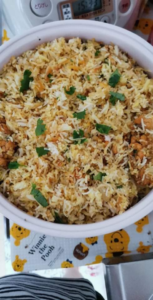 Food is a vital topic for me, as I am a big foodie and love to cook as well. And more than cooking and eating, I love to share my food. I have always shared the food I cook with my friends and colleagues. In particular, I love to cook Indian dishes.
Food is a vital topic for me, as I am a big foodie and love to cook as well. And more than cooking and eating, I love to share my food. I have always shared the food I cook with my friends and colleagues. In particular, I love to cook Indian dishes.
Almost a decade ago, the Japanese people I met and worked together with had a very different approach to Indian or Nepalese spicy curry. Recently though, Japanese people seem to have changed taste buds, and have a new appreciation for traditional Indian/Nepalese fare.
In the early days, I would only share my cooking with my non-Japanese friends who were already familiar with the tastes of our homeland. Once I started working as an ALT, it provided me opportunity to meet young Japanese teachers, and I was able to share my food with them. And to my surprise, they all seem to like it. They liked it so much that I even shared recipes with them. I cooked dishes like butter chicken curry and samosa with my fellow teachers (about 15-20 of them) and they all enjoyed it.
Was it genuinely appreciated? Well I can not really answer that question, as being polite is their nature. But I felt that they did. It really helped to break the ice between us. Many times since then, sharing recipes has worked as a real ice breaker when meeting new people.
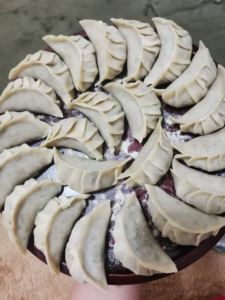 I am still sharing my cooking, both food and recipes, with my new co-teachers. Cooking and sharing my food has not only helped me get along with my fellow teachers, but also let me understand changes in Japanese society.
I am still sharing my cooking, both food and recipes, with my new co-teachers. Cooking and sharing my food has not only helped me get along with my fellow teachers, but also let me understand changes in Japanese society.
Over a decade ago, before I became an ALT, some of my then-colleagues would say that my food is smelly and would not eat with me. Now, things have changed . Some of my coworkers even think that I am in a wrong profession! They think opening a restaurant would suit me better. “Well ,that has always been my ‘Plan B’ ” I reply to them happily.
To be honest, cooking is my stress buster. I live alone. Every time I cook something for myself, it tends to be too much for one person, so I share with my friends. I cook a bit more then usual and share if someone is interested to eat . Additionally, it’s a way to be remembered by my friends.
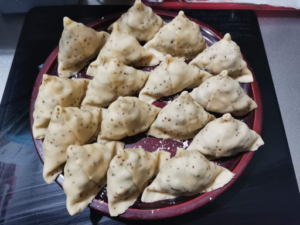 Even if we part ways after working together for a while, I feel we can stay connected with the memories of such sharing of food. Our brain can forget, but our heart doesn’t and especially not our stomachs or taste buds.
Even if we part ways after working together for a while, I feel we can stay connected with the memories of such sharing of food. Our brain can forget, but our heart doesn’t and especially not our stomachs or taste buds.
There is an old proverb in my country which goes: “The way to a man’s heart is through his stomach”. I’m not sure it’s worked for me as described (referring to a man’s heart), but it sure did help me get to my friends’ hearts.
Overall, I feel that the approach of Japanese people towards hot and spicy food has changed with time. In some small way, I like to think I have been a part of that change. I’ve enjoyed sharing my culture through my food. And I hope the friends who tasted it enjoyed it too!
Photo Credits:
Top Photo: kumakoさん on PhotoAC
All additional images provided by the original author (Kabita Gurung), used with permission
All other content (text) created by the original author and © 2023 MUSUBI by Borderlink
Top photo: naophoto11さん on PhotoAC
If you are seeking a subtropical escape from the frigid climes of Honshu this winter season, look no further than the Yaeyama Islands. Located at the far end of Okinawa, Japan’s southernmost prefecture, it is about as far away as you can get from Kanto or Kansai without leaving Japan! Indeed, the islands were formerly known as the Ryukyus, an independent kingdom that developed cultures and languages highly distinct from those of Japan.
While the island beaches and coral reefs have long been the place for water sports aficionados, the relatively warmer temperatures (with average highs of 20 degrees centigrade) in Okinawa from December to February lend themselves equally well to onshore explorations.
Here are some of my recommendations for places to check out:
Ishigaki Island: blue oceans and Ryukyuan culture
The best way to explore Ishigaki at your own pace is to rent a car. If not an option, consider joining a small group tour offered by Utakuna Ishigakijima. You can join a tailor-made excursion to see the islands from a local perspective.
The jewel of Ishigaki’s beaches is Kabira Bay, which faces out onto an emerald-blue lagoon that evokes a desert island in the Pacific Ocean. Postcard views are to be had from the higher up observation platform located near a small shrine. Swimming is not permitted here, however taking a glass-bottom boat cruise run by Kabira Marine Service of the vibrant coral reefs is a rewarding experience.
Iriomote Island: The “Last Jungle” of Japan
A 35-minute ferry ride from Ishigaki Ferry Terminal will take you across the seas to Ohara Port on Iriomote. What sets this apart from other Okinawan Islands is the lush primeval jungle that covers 90% of the island surface. A designated National Park, its three mountains are among the highest in the Okinawan archipelago.
It is possible to spot the beautiful and rare Iriomote wild cat at night expeditions, but they are critically endangered, with only some 150 individuals left. You can also discover the numerous other species unique to Iriomote, including the crested serpent eagle, the Kishinoue giant skink and the Ryukyu yellow-margined box turtle.
Further Exploration
Trekking and canoe tours are more stimulating ways to learn more about this
island’s nature and wildlife while enjoying breathtaking scenic spots. These include the waterfalls at Kanpire, Mariyudu and Pinaisara. Tours are run by knowledgeable local guides with private vehicle transfer included, and many custom options are also available.
A great way to finish your trek around Iriomote is with a relaxing ride over to Yubu Island off the coast. The taxi of choice here is none other than a buffalo cart! There are some 40 trained Asian water buffalos, known to the locals by name, which trudge the shallow waters between the two isles in 15-20-minutes. Yubu Island, just over 2 kilometers in circumference, is dubbed the ‘flower paradise’ and we soon found out why: the entire island is like a botanical garden.
There’s no shortage of things to experience in Okinawa. Here are a few more ideas!
Photo Credits:
Top photo: naophoto11さん on PhotoAC
All other content (text) created by the original author and © 2023 MUSUBI by Borderlink
Top photo: Photo by TOMOYA10002さん on PhotoAC
What’s the first thing that pops into people’s head when they think of Japan? Sushi, probably their favorite anime, maybe ninjas, and of course, sumo wrestling.
Sumo is the national sport of Japan. But it’s a bit unfair to call sumo just a sport. It’s a way of life. Thousands of years of traditions and culture come together inside a small ring and clash into each other headfirst. It’s a magical sport. So many people think about sumo, but too few really know what it is, and even fewer would ever attend a match in Japan. I hope I can change that.
The Basics
First, let’s look at the rules of sumo. This is pretty simple because there are not a whole lot of rules. Two men meet in the ring. The match starts when both men touch their hands to the ground. The match ends when something other than the bottom of their feet touches the ground or either is thrown out of the ring.
Beyond that, almost anything goes. Sure there’s a few illegal moves: no punching, no eye gouging, etc. However the only thing the wrestlers ever try to get away with is hair pulling. There’s too much honor in sumo for then to act dirty.
There’s also no weight classes. Putting on bulk tends to be the best strategy, which is why some wrestlers are over 200 kg. But even at the highest levels, there are surprisingly slim fighters who refuse to get pushed around. I would hesitate to call any sumo wrestler ‘fat’. A few may sport a huge stomach, but there’s nothing but muscle underneath. They are true warriors. Some just enjoy the chanko – the delicious and filling soup all trainees consume by the gallon – more than others.
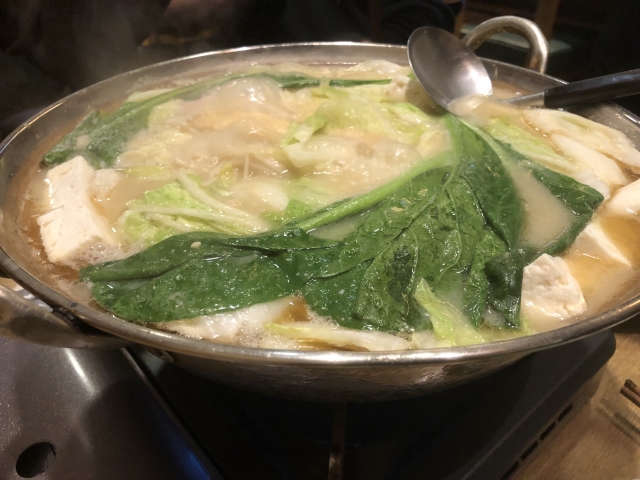
Photo by 山西ワークス
The Traditions
Before each match is an extended ceremony. These are quite a bit longer than the matches themselves. Sumo is all tradition, and everything they do has a meaning. The wrestlers enter with beautiful designs hanging from their mawashi (belts). They cleanse the ring by throwing salt and cleanse themselves by drinking chikaramizu, literally “power water.” Then they practice the starting position in an extended warm up before the match.
I’ll be honest with you, some of these ceremonies are pretty boring when you first start off. That’s understandable. As you grow to know the different sumo wrestlers and learn about their different approaches and personal rituals, you’ll have more respect for these. Feel free to tune out, but pay attention to the gyoji (referee). If he is facing to the side, it’s still warm up time. When he faces the two wrestlers, it is about to start for real.
The Rankings
The true meat and potatoes of sumo comes in the ranking system. The ultimate goal of every wrestler is to climb up the ranks. If they win most of their matches, they rank up, and if they lose too much they go down. There’s six separate divisions in sumo, with wrestlers ranked numerically within them. The top division is called makuuchi and the next is called juryo.
The bottom four are only followed by the most hardcore of sumo fans. These are where the prospects fight. All you really need to know about those are 1) they only fight in a best of seven series, and 2) these guys are not paid. So they want to get out of those ranks as fast as possible.
In the top two paid ranks, they fight 15 matches over the course of one basho (tournament). If someone goes 8-7 or better, he ranks up. There are only wins and losses, and even injuries count as a L. Once a wrestler fights his way to the number one spot of the number one division, there’s a few special ranks. First, from lowest to highest, are komusubi, sekiwake, and ozeki. Then, if a wrestler displays consistent strength and can still win as an ozeki, they will be promoted to the highest level, yokozuna. Only 73 warriors in history have reached this level, but this is the ultimate goal.
The Experience
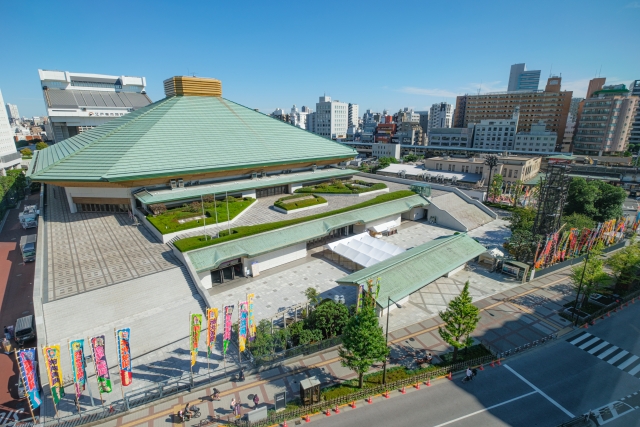
Photo by せき散歩
The current yokozuna – Terunofuji – had quite the journey. While he reached the ozeki rank, injuries and other problems made him drop out of the paid divisions. Usually, when a veteran falls back like this it’s a sign they need to retire. But Terunofuji fell even more. He dropped all the way to the very bottom division. That’s when the fighting spirit kicked in. He came roaring back and ascended the entire mountain, becoming a near unbeatable champion. This is considered one of the greatest comeback stories in any sport.
If you want to watch Terunofuji or the other wrestlers, it’s actually quite easy. There are six bashos a year, starting in January and going every other month. They all last for 15 straight days, starting and ending on a Sunday. NHK is the television provider for sumo events – they have bilingual broadcasts and a pretty in-depth beginner’s guide on their website. There’s plenty of great YouTube channels as well, some editing the long day into 15 minute videos.
And then going to the match is also a great experience. Three of the annual bashos are held at Tokyo’s famous Ryogoku Kokugikan, while the other three alternate between Osaka, Nagoya, and Fukuoka. They also recently restarted one-day traveling exhibition shows during the off-season. While it can be difficult to get a ticket on the final two days, it shouldn’t be a problem picking up a midweek show. Just be warned, the first floor has traditional-style floor seats.
I hope everyone can enjoy watching sumo. Who will you be cheering for?
Photo Credits:
Top photo: Photo by TOMOYA10002さん on PhotoAC
Additional photos by 山西ワークス and せき散歩
All other content (text) created by the original author and © 2023 MUSUBI by Borderlink
All of us at MUSUBI would like to wish you a Happy New Year, and welcome you to 2023!
2022 turned out to be our best year yet, with articles twice a week, every week. That’s over a hundred articles in total!
None of these would be possible without our talented writers- the ALTs and office staff who contribute articles to help set this blog all about Japan apart. At MUSUBI, we always want to provide genuine views from those experiencing Japan first-hand, whether is be about small everyday things or momentous events and festivals.
We also owe thanks to your, the readers. November and December saw some of the most visits to this blog ever! We’ve seen what sort of content has proven the most popular with visitors, and we’ll try to bring you more of it in the coming year. We hope you’ll keep coming back every week, and that present-day readers will someday become future writers as they embark on their own journey to Japan!
Thank you to all who visit and enjoy MUSUBI. We hope to make 2023 even better as we approach our 3rd anniversary!
本当にありがとうございます!
– The entire MUSUBI Staff
Photo Credits:
Top Photo: “Mount Fuji in the Morning” by Lupa L., taken for MUSUBI by Borderlink ©2023.
All other content (text) © 2023 MUSUBI by Borderlink
